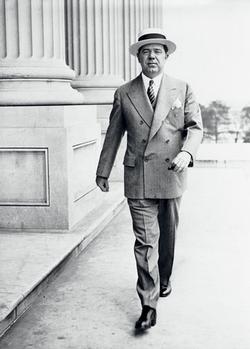
The most famous filibuster in US Senate history? It took place in the summer of 1939, when freshman senator Jefferson Smith, an idealistic Western-state maverick, came to Washington and ran into trouble with the powers that be on Capitol Hill.
The result: a dramatic one-man talkathon against a land grab, followed by 11 Oscar nominations and a new awareness by millions of moviegoers about the way Washington conducts the public’s business.
Inspiration for Mr. Smith Goes to Washington, the Frank Capra film that made Jimmy Stewart a star, may have come from an actual filibuster conducted by Senator Huey Long of Louisiana four years earlier.
For more than 15 hours, Long—opposing a bill that would affect federal appointments in his home state—read from the Constitution, the Bible, Shakespeare, and various cookbooks detailing the right way to prepare shrimp, crabs, and the Southern delicacy known as potlikker.
Only when nature called and he had to go to the men’s room—at four am—did the colorful Louisiana lawmaker relinquish an otherwise empty Senate floor.
Not that Long holds the record for the longest filibuster in Senate history. That distinction belongs to Strom Thurmond, who in 1957 talked for 24 hours and 18 minutes against a proposed civil-rights bill. Taking a lesson from Long’s experience, the South Carolina senator drank few liquids and subsisted on malt tablets and a steak sandwich.
What makes this political history relevant is the likelihood that at some point in the next 12 months a vacancy will occur on the US Supreme Court, triggering the longest Senate filibuster since another Democratic president faced Republican resistance to a high-court nominee.
The President at the time was Lyndon Johnson. His nominee was Abe Fortas, already on the court but up for promotion to chief justice to replace Earl Warren. Michigan senator Robert Griffin had other ideas, however. With the 1968 presidential campaign in high gear and odds favoring the election of Republican Richard Nixon, Griffin and a handful of his GOP colleagues dug in to block Fortas’s confirmation.
According to Garry Gamber, an authority on the history of filibusters, the debate over the Fortas nomination was a radical departure from the way the Senate had traditionally dealt with court appointments. Never before, says Gamber, had a judicial nominee gone before the Senate Judiciary Committee to be grilled about his philosophy and record. And never had opposition senators conducted a filibuster to block a Supreme Court appointment.
It was a milestone. Fortas’s nomination failed to go through, and every Supreme Court nominee who followed Fortas would come under partisan scrutiny. In one case—George H.W. Bush’s appointment of David Souter in 1990—it was said that the best thing the nominee had going for him was a record so bland that it “left no tracks.”
When Lyndon Johnson nominated Abe Fortas in 1968, he had no warning of the firestorm that lay ahead. The same won’t be true of Barack Obama as he prepares to make his first appointment to the high court.
Whoever is nominated will run the same partisan gauntlet that has faced Democratic and Republican nominees alike over the last four decades. And given the rumblings from the Republican base, it’s a matter that won’t be resolved by a bipartisan deal or anything short of a full-scale filibuster.
“It’s more than just payback,” says one GOP committee staff member, recalling the problem the Bush administration had getting its court nominees approved, especially by a Democratic Senate. “It’s about Roe v. Wade, the abortion issue, and even if we can’t win in the long run, the base expects a fight to the bitter end.”
Exit polls taken during 2008’s presidential election bear out the point. The GOP’s social-conservative base viewed the election as a referendum on replacing such pro-choice judges as 89-year-old John Paul Stevens and 76-year-old Ruth Bader Ginsberg with young conservative jurists like John Roberts and Samuel Alito.
For the diehards, say Republican observers, the presidential election may be lost but the fight over the Court’s composition goes on. Whatever name Obama sends to the Senate, social conservatives will burn up the talk-show phone lines in opposition.
The list of possible nominees to the Supreme Court—the vote that would shore up the current 5-to-4 majority favoring Roe—is long and varied. It includes governors Deval Patrick of Massachusetts and Jennifer Granholm of Michigan, DC Court of Appeals judge Merrick Garland, Second Circuit judge Sonia Sotomayor, Seventh Circuit judge Diane Wood, and Chicago law professor Cass Sunstein.
Whoever gets the call will be grilled over whether he or she has any unreported tax problem, employs an illegal nanny, belongs to any restricted private club, or has ever taken lecture fees from questionable sources. The hotter the grilling, the happier the base.
But barring a major slip-up by the White House vetting operation, the nomination should pass through the Judiciary Committee and reach the Senate floor, where the real fight will begin.
The likely scenario: With South Carolina’s Jim DeMint and Oklahoma’s Tom Coburn in the lead, a full complement of Republican caucus members—especially those up for reelection in 2010—will hold the Senate floor to filibuster the nominee’s qualifications through extended readings from the Constitution, the Bill of Rights, and legal journals that argue the need for strict constructionist judges to preserve the vision of the Founding Fathers.
How long will the filibuster last? At least a week, possibly more, before the Democratic leaders round up the 60 votes to invoke cloture and shut down debate.
In short, don’t count on a brief 24-hour interlude. Whatever differences exist between Democrats and Republicans, they find common ground in one of the first principles of the Senate club: What goes around comes around.
Today’s majority, as Democrats learned in 1994 and Republicans discovered 12 years later, could be tomorrow’s filibustering minority.
This article first appeared in the May 2009 issue of The Washingtonian. For more articles from that issue, click here.

















